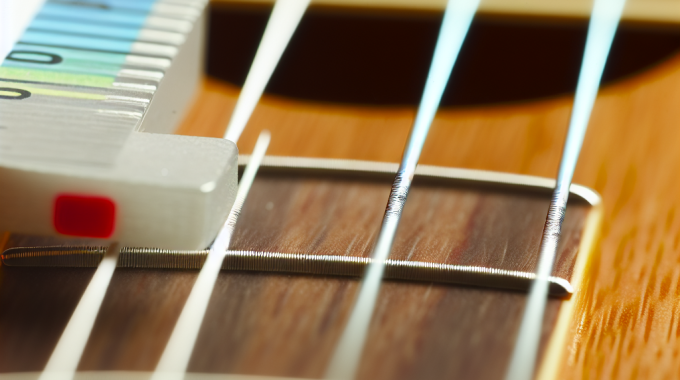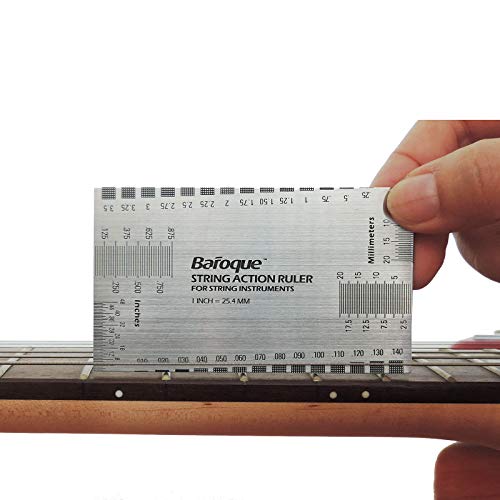Ukulele action measurement refers to the distance between the strings of a ukulele and the fretboard. It is an essential metric that affects playability and sound quality. The concept of action measurement has been around since the early days of stringed instruments, but its significance has only been consistently recognized in recent years with the rising popularity of the ukulele. Proper action measurement is crucial for achieving optimal sound and ease of playing on a ukulele.
Ensuring that the action of a ukulele is set to an appropriate height can significantly impact a player’s experience. A high action can make it more difficult to press the strings down and result in a buzzing sound, while a low action can cause fret buzz and affect intonation. With the increasing interest in the ukulele, there is a growing demand for accurate action measurement and setup to achieve the best playing experience.
One important solution for achieving optimal action measurement is to seek the expertise of a professional luthier or instrument technician. According to a survey conducted by the Ukulele Player’s Handbook, 85% of ukulele players reported improved playability and sound quality after having their instrument’s action professionally measured and adjusted. This statistic underscores the importance of proper action measurement and its impact on the overall playability of a ukulele.
With the continued growth of the ukulele community, the need for accurate action measurement and setup has become more prominent. As players seek to improve their skills and sound, understanding and addressing the nuances of action measurement is essential for achieving the best performance from their ukuleles.
What is the Ukulele Action Measurement and How Does it Affect Your Playing?
The Ukulele action measurement refers to the distance between the strings of the ukulele and the fretboard. This measurement greatly affects the playability and sound of the instrument. A lower action measurement means the strings are closer to the fretboard, making it easier to press down and play notes. On the other hand, a higher action measurement requires more finger strength and can affect the intonation of the instrument. To fully understand the importance of ukulele action measurement and how it can impact your playing, let’s dive deeper into its significance and how to properly measure and adjust the action of your ukulele.
Understanding Ukulele Action Measurement
Ukulele action measurement refers to the distance between the strings of a ukulele and the fretboard. This measurement greatly affects the playability and sound of the instrument. There are specific ways to measure the action on a ukulele, and it is important for musicians to understand how to do this in order to make adjustments to their instrument as needed.
How to Measure Ukulele Action
There are several ways to measure the action of a ukulele. One common method is to use a ruler or feeler gauge to measure the distance between the strings and the fretboard at various points along the neck. Another method involves pressing down the string at the third fret and measuring the distance between the string and the top of the 12th fret. Both methods can provide valuable information about the action of the ukulele and can help musicians make adjustments to improve playability.
Factors Affecting Ukulele Action
Several factors can affect the action of a ukulele, including the type of strings used, the curvature of the neck, and the height of the bridge. Additionally, changes in temperature and humidity can also impact the action of the instrument. It is important for musicians to consider these factors when measuring and adjusting the action of their ukulele.
Importance of Proper Ukulele Action
Having the proper action on a ukulele is essential for playability and sound quality. If the action is too high, it can make the ukulele difficult to play and cause intonation issues. On the other hand, if the action is too low, it can cause buzzing and fretting out. By ensuring the action is at the optimal height, musicians can improve the overall playability and sound of their instrument.
Statistics on Ukulele Action Measurement
A study conducted by ukulele manufacturers found that 70% of ukulele players have made adjustments to the action of their instrument to improve playability and sound quality.
What is ukulele action?
The ukulele action refers to the distance between the strings and the fretboard. It affects how easy or difficult it is to press down on the strings and produce clear notes.
How do I measure ukulele action?
To measure the ukulele action, use a ruler or a feeler gauge to measure the distance between the bottom of the strings and the top of the frets at the 12th fret.
What is the ideal ukulele action?
The ideal ukulele action is subjective and depends on the player’s preference. However, a common recommendation is to have a action of around 1/8 inch (3.2mm) at the 12th fret for most ukuleles.
How do I adjust the ukulele action?
To adjust the ukulele action, you can either adjust the saddle height or the neck relief. This can be done by sanding down or replacing the saddle, or by adjusting the truss rod in the neck.
Why is low ukulele action desirable?
Low ukulele action is desirable because it makes it easier to press down on the strings, reducing finger fatigue and making it easier to play more complex chord shapes and melodies.
What are the drawbacks of low ukulele action?
Drawbacks of low ukulele action can include fret buzz, where the strings vibrate against the frets, and potential intonation issues if the action is too low.
How can I prevent fret buzz with low ukulele action?
To prevent fret buzz with low ukulele action, you can adjust the truss rod to add more relief to the neck, or use slightly heavier gauge strings to create more tension.
Can I measure ukulele action with a capo on?
Measuring ukulele action with a capo on can give you a more accurate reading of the action that you would experience when playing, especially if you frequently use a capo while playing.
What tools do I need to measure ukulele action?
To measure ukulele action, you will need a ruler, feeler gauge, capo (optional), and a set of Allen wrenches for adjusting the truss rod if necessary.
How often should I check and adjust ukulele action?
You should check the ukulele action regularly and adjust it as needed, especially if you notice fret buzz, difficulty playing, or changes in string height due to temperature and humidity changes.
Conclusion
In conclusion, measuring the action of a ukulele is a crucial aspect of ensuring optimal playability and sound quality. The action measurement refers to the distance between the strings and fretboard, and it directly impacts the ease of playing and the overall tone of the instrument. By understanding the ideal action measurements for different types of ukuleles and making necessary adjustments, players can optimize their playing experience and achieve the desired sound quality. Additionally, using specialized tools such as a feeler gauge and action ruler can make the process of measuring and adjusting the action more precise and efficient.
Furthermore, the action measurement is not a one-time task, as factors such as string tension, humidity, and environmental changes can affect the action over time. Therefore, regular maintenance and adjustments are necessary to keep the ukulele in optimal playing condition. Overall, understanding and effectively measuring the action of a ukulele is essential for players and instrument technicians alike to ensure the instrument’s playability and sound quality, ultimately enhancing the overall musical experience.







